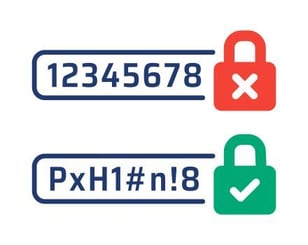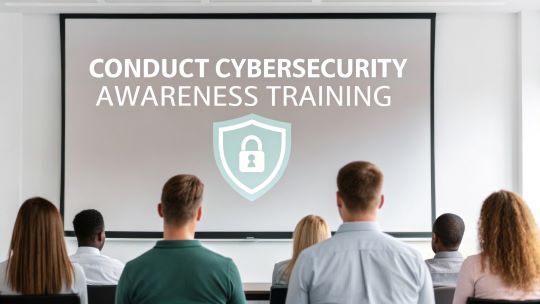
Just like your home needs a good spring cleaning, your technology and data need regular organization too. Cybersecurity best practices act like a home organization system for your digital life - keeping your accounts, passwords, and access permissions tidy, updated, and secure. This guide will show you proven methods in protecting your information while making sure your systems run smoothly using smart organization techniques. Learning the straightforward steps to defend yourself against current threats and build a more secure foundation for your business and personal data. Cleaning out your closets this Spring? Make sure you take care of your digital clutter as well!
 Digital Spring Cleaning for Access Management
Digital Spring Cleaning for Access Management
Decluttering your digital life is an essential cybersecurity practice, best for maintaining a secure environment.
Review User Access
When was the last time you reviewed who has access to your systems and data? If it's been a while, now is the perfect time to conduct a thorough audit. Here's what you can do:
- Identify all users who have access to your network, applications, and data.
- Review each user's permissions.
- Ask yourself if they still need that level of access to perform their job duties.
- If not, revoke or modify their permissions.
Update Password Policies
Take a close look at your password policies. Are you enforcing strong, unique passwords for each account? Do you require regular password changes? If not, it's time to update your policies and communicate them to your users. Implementing multi-factor authentication (MFA) can provide an added layer of security.
Review Third-Party Vendor Relationships
Another important aspect of digital spring cleaning is reviewing your third-party vendor relationships. Make sure you have a clear understanding of what data you're sharing with each vendor and how they're protecting it. If a vendor no longer needs access to your systems or data, terminate their access immediately. When we start working with a new business, we often see very old credentials still in the system - don't let this be you!
Lead by Example
Don't forget about your own access management practices. Here are a couple of questions to ask yourself:
- Are you following the principle of least privilege by only granting yourself the permissions you need to do your job?
- Are you using strong, unique passwords for all your accounts?
Remember, leading by example is one of the most effective ways to encourage your team to take cybersecurity seriously.
Digital spring cleaning may seem like a daunting task, but it's an essential part of maintaining a secure environment. By regularly reviewing and updating your access management practices, you can help protect your organization from cyber threats. While also ensuring that your critical systems and data remain secure.
 Digital Life Declutter Through System Updates
Digital Life Declutter Through System Updates
As you embark on your digital spring cleaning journey, focusing on cybersecurity best practices is essential to declutter your digital life. One key aspect of this process is ensuring all your devices and software are up-to-date with the latest system updates.
The Importance of System Updates
System updates often include critical security patches and bug fixes that protect your devices from vulnerabilities and potential cyber threats. Regularly updating your operating systems, applications, and firmware significantly reduces the risk of falling victim to malware, hacking attempts, and data breaches. Old tech doesn't protect against new threats!
Streamlining the Update Process
To make the update process more efficient, consider enabling automatic updates whenever possible. This way, you don't have to manually check for and install updates, saving you time and effort. If automatic updates aren't available or you prefer more control, here's what you can do:
- Set reminders to check for updates periodically, such as once a week or month
- Dedicate a specific time slot for updating your devices and software
- Create a checklist to ensure you don't miss any important updates
Don't Forget Your Mobile Devices
Your smartphones and tablets also require regular updates to maintain optimal security and performance. Keep them updated with the latest operating system versions and app updates to protect your personal information and prevent potential security risks. Resist the temptation to hit "postpone" on updates - just do it!
Securing Your Home Network
In addition to your devices, remember to update your router's firmware. Routers act as the gateway to your home network, so keeping them secure is crucial. Manufacturers often release firmware updates that address security vulnerabilities and improve overall performance.
Decluttering Your Digital Life
As part of your digital decluttering efforts, take inventory of the devices and software you use regularly. Here are some tips to help you streamline your digital life:
- Uninstall any unused or outdated applications to reduce clutter and potential security risks
- Focus on the tools and programs that genuinely add value and enhance your productivity
- Organize your files and folders to make it easier to find what you need
Embracing a proactive approach to system updates not only enhances your cybersecurity posture but also contributes to a more organized and efficient digital life. Dedicating time to regularly update your devices and software creates a solid foundation for your digital spring cleaning initiatives, ensuring a safer and more streamlined digital experience.
Network Security Spring Refresh
As you embark on your digital spring cleaning journey to declutter your digital life, it's essential to focus on cybersecurity best practices. Just as you would tidy up your physical space, take the time to refresh and secure your network and devices.
Update Software and Operating Systems
Start by updating all your software and operating systems to the latest versions. These updates often include critical security patches that protect against newly discovered vulnerabilities. Don't forget to update your router's firmware as well.
Review and Strengthen Passwords
Next, review and strengthen your passwords:
- Use unique, complex passwords for each account.
- Consider using a password manager to keep track of essential information - unless you're an extreme memory expert, you won't be able to memorize all your passwords!
- Enable two-factor authentication wherever possible for an extra layer of security.
Evaluate Apps and Browser Extensions
Take a close look at the apps and browser extensions installed on your devices. Remove any that you no longer use or don't recognize. Be cautious when installing new apps and only download from trusted sources.
Back Up Important Data
Backing up your important data is another crucial aspect of your digital spring cleaning. You can use a combination of cloud storage and external hard drives to ensure you have multiple copies of your files in case of a security breach or device failure. This way, even if something happens to one backup, you'll still have access to your data.
Educate Yourself and Others
Finally, educate yourself and family members about common cyber threats:
- Phishing scams
- Malware
- Social engineering tactics
Stay vigilant when clicking on unsolicited links, downloading unknown attachments, or providing personal information online. If you receive an unexpected email claiming to be from your bank or another service provider, it's best to visit their website directly instead of clicking on any links in the message.
By following these cybersecurity best practices and regularly decluttering your digital life, you can enjoy a more secure and organized online experience. Just as spring cleaning refreshes your home, a network security refresh can give you peace of mind and protect your valuable data.
 Best Practices for Security Awareness
Best Practices for Security Awareness
As you declutter your digital life this spring, consider these tips to enhance your security awareness.
Use Strong, Unique Passwords
One of the most important things you can do is use strong, unique passwords for each account and enable two-factor authentication whenever possible. Avoid reusing passwords across multiple sites or services.
Keep Software Up to Date
Make sure to keep your software and operating systems up to date with the latest security patches and updates. You can enable automatic updates to ensure you don't miss critical fixes.
Be Cautious with Links and Attachments
Here's a tip: be cautious when clicking links or downloading attachments from unknown sources. Phishing attacks often use convincing emails to trick you into revealing sensitive information or installing malware.
Back Up Your Data
Regularly backup your important data to an external drive or cloud storage service. This protects your files in case of a ransomware attack or hardware failure. Keep in mind that if you don't keep a backup offsite, a theft or building disaster could wipe away your backup.
Use Antivirus Software
It's a good idea to use a reputable antivirus program and keep it updated to detect and remove malware. Run regular scans to catch any potential threats.
Be Mindful on Social Media
Be mindful of what you share on social media. Avoid posting personal information that could be used for identity theft or social engineering attacks.
Use a VPN on Public Wi-Fi
When connecting to public Wi-Fi networks, use a virtual private network (VPN). This encrypts your internet traffic and helps protect your data from prying eyes.
Educate Yourself and Your Employees
Educate yourself and your employees about the latest cybersecurity threats and best practices. Regular training can help reduce the risk of human error, which is a common cause of data breaches.
By following these digital spring cleaning tips, you can declutter your digital life and enhance your security posture. Remember, cybersecurity is an ongoing process that requires vigilance and proactive measures to stay ahead of evolving threats.
Download the infographic to share with your team at your next team meeting.
Quick Tips - Re-Cap:
🌷 Spring Cleaning for Cybersecurity: 10 Essential Tips for Small Businesses, Nonprofits & Municipalities 
🧹 1. Review User Accounts & Access
-
Remove ex-employee accounts.
-
Audit shared accounts or admin privileges.
-
Check for unused vendor logins or contractors.
🌼 2. Update Password Policies
-
Ensure staff are using strong, unique passwords.
-
Encourage (or enforce) the use of password managers.
-
Require multi-factor authentication for all critical systems.
🧼 3. Patch and Update Everything
-
Install software and OS updates.
-
Check firmware on firewalls, routers, and printers.
-
Don’t forget “forgotten” devices (conference rooms, kiosks, spare PCs).
🌸 4. Audit Your Backups
-
Confirm your backups are running, current, and tested.
-
Make sure critical files are backed up offsite or in the cloud.
-
Verify that backups aren’t connected directly to production systems.
🧽 5. Check Email Security Settings
-
Confirm SPF, DKIM, and DMARC are properly set up.
-
Review spam filter rules and quarantine policies.
-
Remind staff to report suspicious emails, not just delete them.
🧺 6. Revisit Who Has Admin Rights
-
Audit local PC admin rights and Microsoft 365 permissions.
-
Follow least privilege principles—only grant what’s necessary.
🌤 7. Scan for Shadow IT
-
Ask: Are staff using unauthorized cloud apps or storage?
-
Inventory all third-party apps with access to your systems.
🚿 8. Update Your Cybersecurity Awareness Training
-
Refresh phishing training modules.
-
Send a company-wide reminder about reporting procedures.
-
Reinforce the “pause and think before you click” habit.
🪴 9. Clean Up Your Device Inventory
-
Reclaim or wipe unused laptops, phones, and tablets.
-
Make sure all active devices are encrypted and tracked.
-
Label and secure physical equipment properly.
🧹 10. Tidy Up Your Policies & Documentation
- Update your cybersecurity policies (bring them into plain English!).
- Document who to call in case of a breach or incident.
- Make sure all staff know where to find your policies and who to contact.
Your Cybersecurity Partner for Safer Business Growth
You want a cybersecurity partner who understands your business challenges and goals. Our team brings decades of direct experience building security programs that protect organizations at every growth stage. We design practical security measures that align with your operations and budget.
Schedule a security assessment with us today to see how we can help you implement proven cybersecurity practices that keep your data protected and your business moving forward.
About the author:
Ann Westerheim, PhD is the Founder and President of Ekaru, a Technology Service Provider of cybersecurity and IT services for small and medium businesses in the greater Boston area. Ann is an accomplished technology innovator and leader with three engineering degrees from MIT. She has twenty years of high tech experience in research, advanced development, product development, and as an entrepreneur. Her career has spanned a vast range of technology endeavors including research in thin film semiconductors and superconductors, microprocessor fabrication, development of early Internet medical applications, and now focusing on the application of technology in business. She has an avid focus on the "last mile" of technology and decreasing the digital divide.
Topic
.png)

